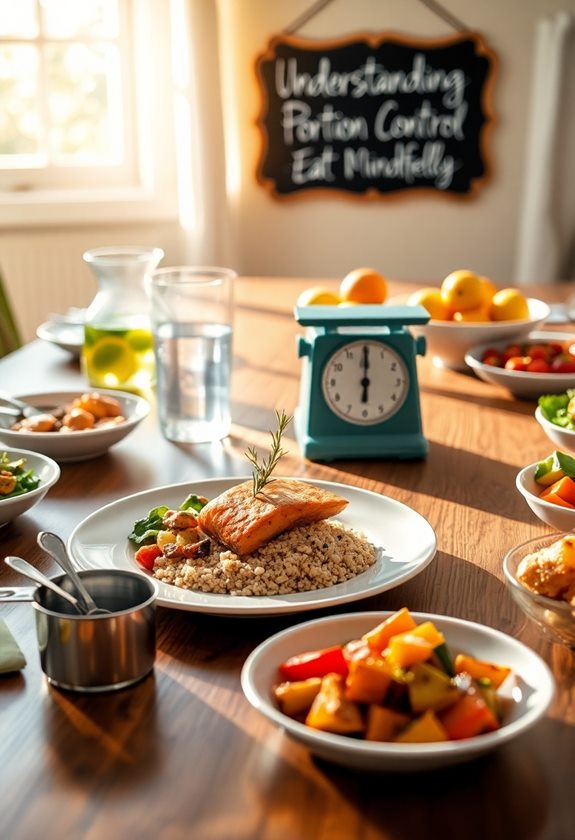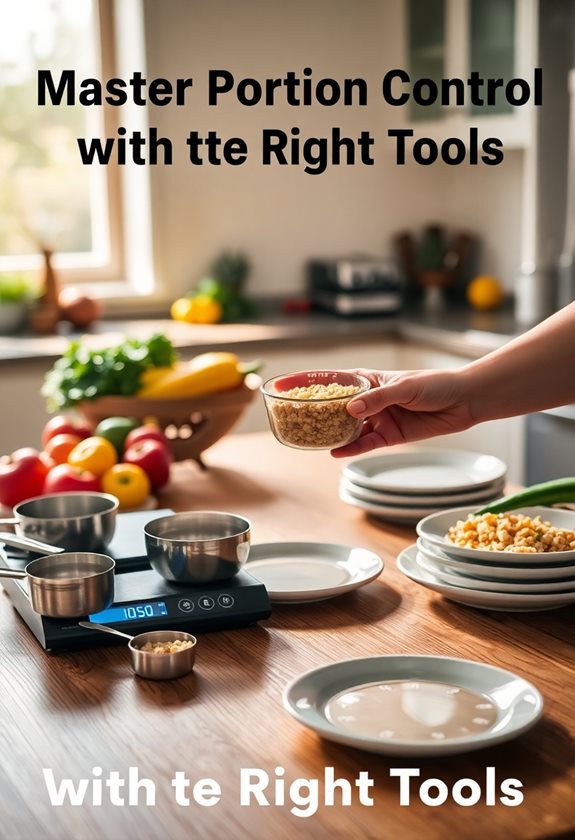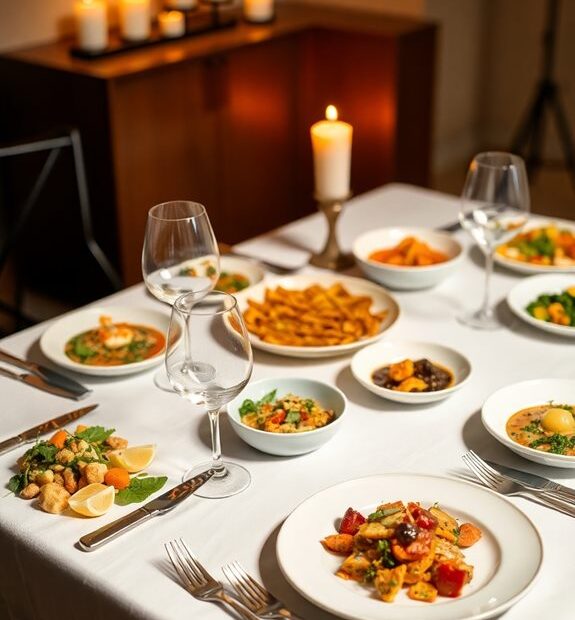Understanding portion control helps you eat mindfully and enjoy your meals. Have you ever noticed how smaller plates can make your portions seem larger? 🍽️ Using measuring cups or a food scale can keep you on track, too. Think about filling half your plate with veggies; it's a great way to eat healthier while feeling full! Also, take a moment to listen to your body's hunger signals. Are you stopping when you're satisfied, not stuffed? 🥗 Setting up a calm dining space can enhance your experience. Want to learn more handy tips to boost your mindful eating journey?
Key Takeaways
- Use smaller plates to create the illusion of larger portions and encourage mindful eating.
- Measure snacks before eating instead of consuming directly from the package to prevent overeating.
- Fill half your plate with vegetables to create balanced, low-calorie meals that promote satiety.
- Practice the "0 to 10 hunger scale" to identify when to eat and when to stop.
- Create a distraction-free environment by organizing your dining area and eliminating electronic devices during meals.
The Basics of Portion Control

Understanding the basics of portion control is key to managing your eating habits effectively. Have you ever looked at your plate and wondered if you're eating too much? It's easy to lose track of serving sizes, especially when meals are served in large bowls or on big plates. One helpful tool to aid in this process is using portion control plates, which are designed to promote balanced eating habits and guarantee nutrient balance by dividing food into sections.
Start by recognizing what a standard portion looks like. For instance, a serving of meat is about the size of your palm, while a serving of pasta should fit in a cupped hand. Using smaller plates can trick your brain into thinking you're eating more than you actually are. Isn't that a neat trick?
Another helpful tip is to measure out snacks instead of eating from the bag. This simple step can prevent mindless munching. You might even want to check food labels for serving sizes. It's surprising how small a serving can be sometimes!
Benefits of Mindful Eating
Mindful eating offers a transformative approach to how you interact with food, enhancing your overall well-being. By focusing on the experience of eating, you can truly savor each bite and appreciate your meal. Have you ever noticed how quickly meals can pass you by when you're distracted? Practicing mindful eating can also complement your importance of meal planning by encouraging you to make healthier food choices and reduce impulsive eating. When you practice mindful eating, you become more aware of your hunger and fullness cues. This awareness helps you make better choices and prevents overeating. Imagine enjoying your favorite dish, really tasting it, and feeling satisfied with less food. Doesn't that sound great?
Another benefit is reduced stress. Taking the time to slow down during meals allows you to relax and enjoy your food. Instead of eating on the go, you create a moment to recharge. Plus, you might find that you enjoy your food more when you give it your full attention.
Lastly, mindful eating can improve your relationship with food. Instead of seeing it as a source of guilt, you start to view it as nourishment. So, why not give mindful eating a try? It could change how you feel about food for the better!
Practical Portion Control Tips

Mastering portion control can greatly impact your eating habits and overall health. It's all about balance, right? Here are some practical tips to help you manage your portions without feeling deprived:
- Use smaller plates 🍽️: It tricks your brain into thinking you're eating more. Additionally, utilizing portion-controlled containers can make it easier to serve appropriate amounts and maintain a balanced diet.
- Measure servings: Start with measuring cups or a food scale for accuracy. You'd be surprised how much a "serving" really is!
- Fill half your plate with veggies 🥦: They're low in calories but high in nutrients. Plus, they make your meal colorful!
Have you ever noticed how easy it is to overeat when you're distracted? Eating mindfully means paying attention to what's on your plate. When you sit down to eat, take a moment to appreciate your meal. It's okay to savor each bite instead of rushing through it.
Recognizing Hunger and Fullness
Recognizing your body's signals for hunger and fullness can transform your approach to eating. Have you ever found yourself mindlessly munching on snacks, even when you're not truly hungry? Tuning into your body's cues can help you make better choices.
Start by checking in with yourself before meals. Are you feeling a rumble in your stomach? That's a clear sign of hunger. But what about after you eat? Do you feel satisfied or stuffed? It's important to notice the difference. Satisfaction means you've had enough, while stuffed often leads to discomfort.
Try using the "0 to 10 hunger scale." At 0, you're starving, and at 10, you're uncomfortably full. Aim to eat when you're around a 3 or 4, and stop when you hit a 6. This practice can help you enjoy your food without overindulging.
Tools for Measuring Portions

When it comes to controlling portions, using the right tools can make all the difference in your eating habits. Think about it: how often have you filled your plate without considering how much you really need? By measuring your food, you can enjoy your meals more and reduce waste. Here are some handy tools that can help you:
- Measuring cups: Perfect for liquids and dry ingredients, they help you avoid guesswork.
- Food scale: This tool gives you an accurate weight of your food, making it easier to track portions.
- Portion control plates: Designed with sections for different food groups, these plates help you balance your meals.
Using these tools can turn a stressful meal into a mindful experience. Have you ever felt overwhelmed by how much to serve? By measuring, you take away that uncertainty. Plus, it can be satisfying to see how a proper portion looks on your plate! You'll find that you might not need as much food as you thought. So, why not give these tools a try? You might be surprised by how much better you feel after a meal! 🍽️
Creating a Mindful Eating Environment
A mindful eating environment is essential for enjoying your meals and making healthier choices. Have you ever noticed how your surroundings can affect your eating habits? When you create a calm and inviting space, you're more likely to savor your food and listen to your body's hunger cues.
Start by clearing your dining area. A clean, organized table helps you focus on your meal. Try dimming the lights or using candles to set a relaxed mood. You could even play soft music to enhance your experience.
Consider your seating as well. Are you sitting comfortably? If you're slouched or distracted, it's easy to overeat. Aim for a neat setup—no TV or phones at the table! This helps keep your mind on your food and encourages you to chew slowly.

